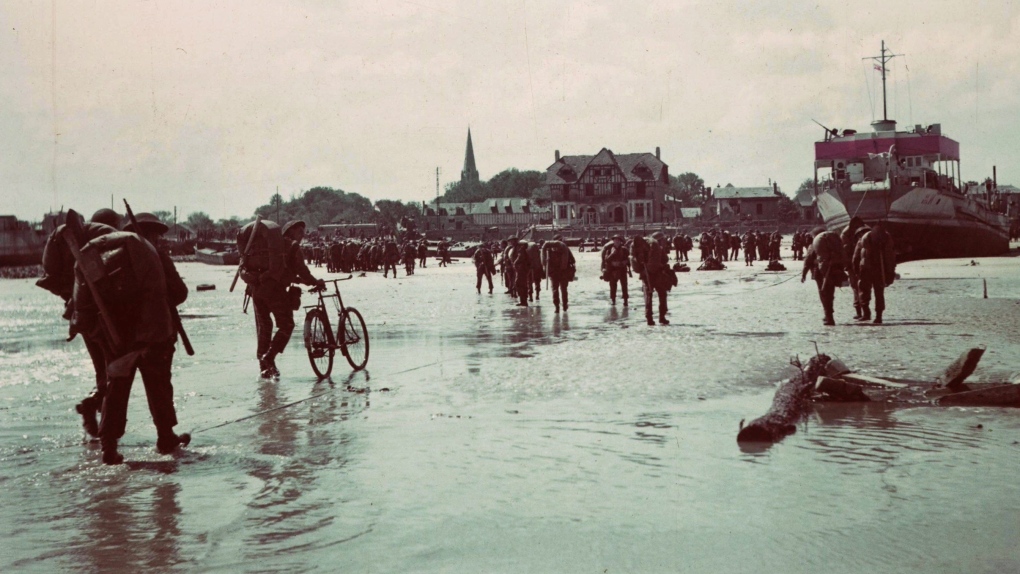'We will remember them': Thousands gather for historic Winnipeg Remembrance Day service
Thousands gathered at the RBC Convention Centre on Monday to bear witness to a sombre and historic Remembrance Day ceremony.
Crowds of veterans, service men and women, and civilians were flanked by Lt.-Gov. Anita Neville, Manitoba Premier Wab Kinew, and Winnipeg Mayor Scott Gillingham.
Wreathes of remembrance were laid and a torch ceremony was held during a reading of “In Flanders Fields.”
The doleful notes of The Last Post sounded throughout the silent crowd.
“This morning, as we reflect upon our blessings, we ask that we may be faithful stewards of the freedom that has been granted,” said Capt. Gabriel Boucher, who served as master of ceremonies.
 A wreath to honour 17 Wing Winnipeg is laid at a Remembrance Day ceremony at the RBC Convention Centre on Nov. 11, 2024.
A wreath to honour 17 Wing Winnipeg is laid at a Remembrance Day ceremony at the RBC Convention Centre on Nov. 11, 2024.
As speakers highlighted ongoing global conflicts currently being fought, including wars in Ukraine and the Middle East, much attention was paid to the past. This year marks the 80th anniversary of D-Day and the 100th anniversary of the Royal Canadian Air Force.
Rev. Paul N. Johnson spent much of his address recounting the bloody battle in Normandy and the contributions and sacrifices made by countless Manitobans.
On June 6, 1944, around 160,000 Allied troops landed on the beaches to begin an effort now remembered as the beginning of the end of the Second World War.
Among them - Captain George Alexander Harris, a priest who left his comfortable post at Winnipeg’s All Saints Anglican Church to join the fight.
“That night, with a battalion he jumped out of a C-47 with all the others. With many others, he was dead before the day was done. We will remember them.”
 Rev. Paul N. Johnson addresses attendees at a Remembrance Day ceremony at RBC Convention Centre on Nov. 11, 2024.
Rev. Paul N. Johnson addresses attendees at a Remembrance Day ceremony at RBC Convention Centre on Nov. 11, 2024.
Manitoba’s contribution on the shores that day are storied, from the tanks of the Fort Garry Horse and the 1st Hassars, who were first ashore on Juno Beach, followed closely by the Royal Winnipeg Rifles.
“Many of them didn’t even make it to shore. Almost a third of the landing crafts were lost to German mine defenses, along with many of the men they carried. Those who made it to shore, they weren’t safe either.”
In a statement, Kinew thanked members of the Canadian Armed Forces, their families and their loved ones for what they have given to the province.
“In their sacrifice and service, each of us as Canadians have been given a great gift of a country that upholds democracy and a life of hard-won freedoms.”
- With files from CTV’s Jon Hendricks and the Canadian Press
 Some of the most vivid film footage of the D-Day landings 75-years ago was shot by a Canadian military film unit using technology obtained from U.S. allies. Canadian soldiers land on a Normandy, France beach during the D-Day invasion June 6, 1944. (THE CANADIAN PRESS/Department of National Defence)
Some of the most vivid film footage of the D-Day landings 75-years ago was shot by a Canadian military film unit using technology obtained from U.S. allies. Canadian soldiers land on a Normandy, France beach during the D-Day invasion June 6, 1944. (THE CANADIAN PRESS/Department of National Defence)
CTVNews.ca Top Stories

Donald Trump says he urged Wayne Gretzky to run for prime minister in Christmas visit
U.S. president-elect Donald Trump says he told Canadian hockey legend Wayne Gretzky he should run for prime minister during a Christmas visit but adds that the athlete declined interest in politics.
Historical mysteries solved by science in 2024
This year, scientists were able to pull back the curtain on mysteries surrounding figures across history, both known and unknown, to reveal more about their unique stories.
King Charles III focuses Christmas message on healthcare workers in year marked by royal illnesses
King Charles III used his annual Christmas message Wednesday to hail the selflessness of those who have cared for him and the Princess of Wales this year, after both were diagnosed with cancer.
Mother-daughter duo pursuing university dreams at the same time
For one University of Windsor student, what is typically a chance to gain independence from her parents has become a chance to spend more time with her biggest cheerleader — her mom.
Thousands without power on Christmas as winds, rain continue in B.C. coastal areas
Thousands of people in British Columbia are without power on Christmas Day as ongoing rainfall and strong winds collapse power lines, disrupt travel and toss around holiday decorations.
Ho! Ho! HOLY that's cold! Montreal boogie boarder in Santa suit hits St. Lawrence waters
Montreal body surfer Carlos Hebert-Plante boogie boards all year round, and donned a Santa Claus suit to hit the water on Christmas Day in -14 degree Celsius weather.
Canadian activist accuses Hong Kong of meddling, but is proud of reward for arrest
A Vancouver-based activist is accusing Hong Kong authorities of meddling in Canada’s internal affairs after police in the Chinese territory issued a warrant for his arrest.
New York taxi driver hits 6 pedestrians, 3 taken to hospital, police say
A taxicab hit six pedestrians in midtown Manhattan on Wednesday, police said, with three people — including a 9-year-old boy — transported to hospitals for their injuries.
Azerbaijani airliner crashes in Kazakhstan, killing 38 with 29 survivors, officials say
An Azerbaijani airliner with 67 people onboard crashed Wednesday near the Kazakhstani city of Aktau, killing 38 people and leaving 29 survivors, a Kazakh official said.

































